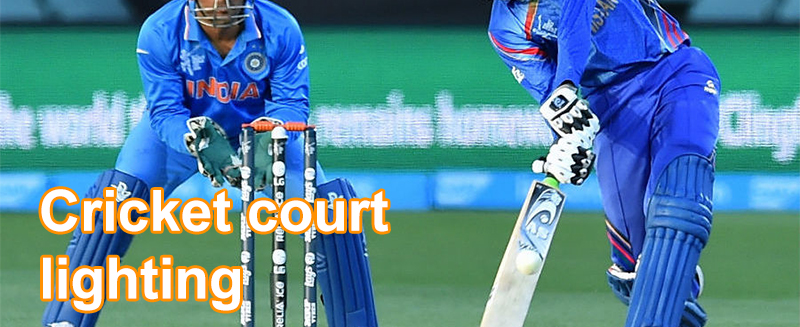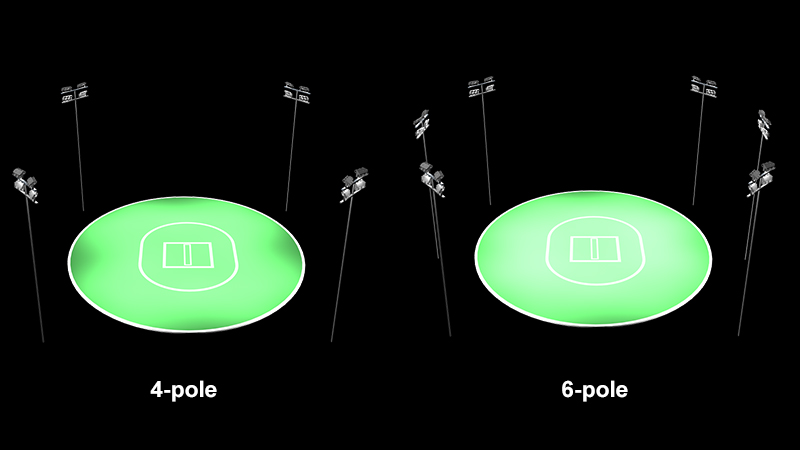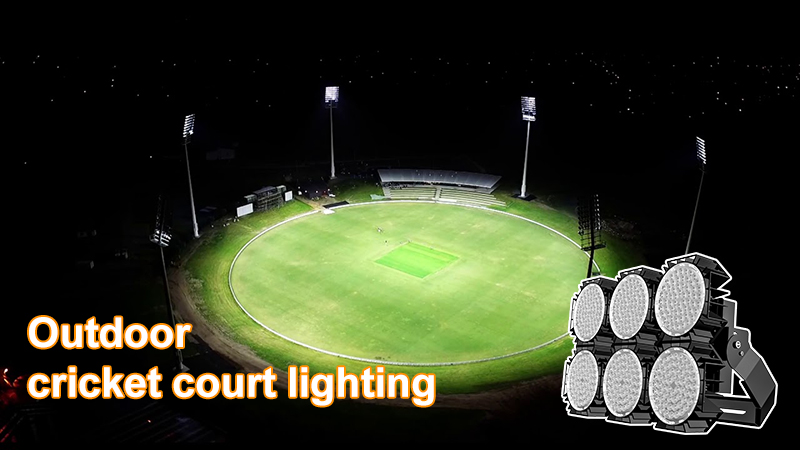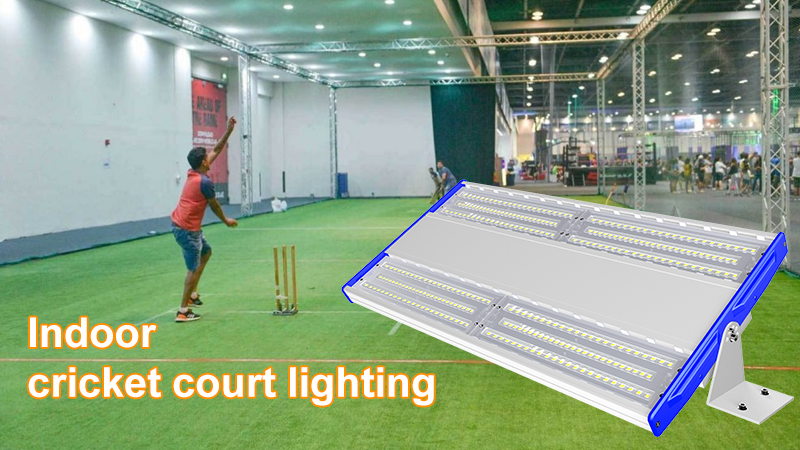
We provide lighting for cricket grounds and stadiums. Cricket is a sport known as a “gentleman’s game”, popular in Australia, New Zealand, Pakistan and other countries. Cricket courts have very high requirements for lighting. Different venues have different requirements for illuminance. The main factors to be considered are illuminance, uniformity of illuminance and IP protection level, etc.

Cricket Court Lighting Standard
id=”Illumination_Standard_for_Training_Cricket_Ground”>
Illumination Standard for Training Cricket Ground
The cricket court, which is only used for training, does not have very high requirements for lighting, because it does not need to consider the visual requirements of the auditorium for the situation in the field, nor the effect of TV broadcast. It only needs to ensure that the field reaches the training time. The illumination requirements are sufficient. Generally speaking, it only need to reach 200 Lux.
Indoor cricket court lighting
Compared with cricket courts that are only used for training requirements, the lighting requirements of indoor cricket courts for entertainment purposes are even higher. Not only does it require a larger number of lamps, but the required illuminance is also very different.The range of its illumination requirements is generally between 300Lux-750Lux, which is formulated in consideration of the heat generated by the light.
Lighting standards for international competition cricket courts
According to the lighting standards established by the International Cricket Committee, for large-scale cricket matches that need to be televised, In view of the large size of this cricket field and the large number of spectators, its illumination is about 1500-2500 Lux.
Cricket Court Lighting Guidance

4-pole lighting arrangement
If it’s just for community entertainment cricket court lighting, the classic arrangement of lamps is to arrange evenly on 4 poles. This arrangement is currently the most suitable and most commonly used arrangement.
6-pole lighting arrangement
Is there any difference between 4-pole lighting arrangement and 6-pole lighting arrangement? Of course, the functions of the cricket court reflected by the 4-pole lighting arrangement and the 6-pole lighting layout are different. Because the number of lights increases, the brightness of the venue will naturally increase, so the cricket court with 6-pole lighting layout has higher lighting requirements. . The fact is indeed the case. Generally, the lighting arrangement of the cricket court for TV broadcast is 6 poles.
Outdoor Cricket Court Lighting Design

1.Illumination uniformity and lighting level
For cricket courts of different purposes, the required illuminance values vary. If it is only used for training and entertainment, the illuminance value needs to reach 250-350Lux; if it is used for holding professional events, its illuminance value needs to reach 500-750Lux; if it is used For the cricket ground that hosts large-scale international events on TV, its illumination value should reach 1500-2500 Lux.
2.Anti-glare
The problem of glare has always been criticized by cricket players, because the glare produced by the lamps will cause glare to the players, which greatly affects the normal performance of the players, especially for this kind of hitting sport, the impact is very obvious. At present, the main solution to the method of controlling glare of led stadium lights is to directly limit the brightness of the light source or use light-transmitting materials to reduce the glare and use the protection angle of the lamp to control the glare.
3.No flicker
Compared with the glare problem, strobe is not as undetectable to the naked eye. So does the stroboscopic problem need to be considered? This need depends on the situation. If the cricket ground is only used for training and entertainment, then the stroboscopic problem can be ignored; if the cricket ground requires a TV broadcast, then the stroboscopic problem becomes very important.
4.Waterproof level
Waterproof grade is only for outdoor cricket court lighting. For outdoor cricket court lighting, waterproof factors must be considered. This is common sense. So how much does the IP level need to be to achieve waterproof performance? Generally speaking, the waterproof performance can be basically achieved by reaching IP65, and the current IP level is up to IP67.
5.Anti-wind and anti-corrosion
As an outdoor cricket court lighting fixture, there are two other factors worth considering. The first is anti-corrosion. If the installed lamps are not well anti-corrosive, the lamp body is easily damaged by rain and oxygen, which will cause additional costs. In addition, the ability of the lighting to resist wind is also very important, because stadium lights are generally installed in relatively high places. If it encounters windy weather, the lighting is likely to be blown off and cause danger.
Operating Cost Of Cricket Court Lighting
Assuming that the total power required to illuminate a cricket venue is 84,000W, the average illuminance value must reach 750Lux, the unit price of electricity is USD 0.12/KWH, and the average lighting time per day is 8 hours, then the electricity cost per day is 84000 w × 8 h × $ 0.12 kwh / 1000=$ 80.64 , then the electricity cost per month is $2419.2 (30 days), which is the cost of using led lighting, but if you are using traditional lighting methods, such as metal halide lamps, then The cost of electricity may be 10 times that of led lights. So, obviously, the electricity cost of led lights is much less than traditional lighting, which is why people think of energy saving when they talk about led lights.
Indoor Cricket Court Lighting Design

1.Glare control
Glare refers to the visual conditions that cause visual discomfort and reduce the visibility of objects due to inappropriate brightness distribution or extreme brightness contrast in space or time in the visual field. There is a sense of light in the field of vision that the human eye cannot adapt to, which will have a great impact on athletes, especially for indoor ball games, where athletes cannot accurately determine where the ball falls.
In order to ensure uniform illuminance at all angles and prevent indoor glare, the elevation angle from the lowest point of the indoor cricket court to the lamps must be greater than 45°. However, because the current indoor cricket court light sources are installed at a higher position and are relatively scattered, in order to prevent Direct exposure to athletes or spectators. Nowadays, indoor cricket courts use computers to calculate light projection points to ensure uniform and reasonable light distribution. Indoor glare will also be caused by the reflection of different floor materials, so you can also install grilles or lampshades for lamps to reduce glare.
2.Cooling system design
Indoor cricket court lighting needs to consider the heat dissipation problem, because the installation method of the lamps is generally ceiling-mounted, so considering the distance between the lamps and the ceiling is too close, the lamps are not as easy to dissipate heat as they are installed outdoors. Therefore, we took into account the high-quality aluminum alloy material that is easier to dissipate heat in the selection of the lamp material, and the hollow design is also adopted in the appearance, which also helps the lamp to dissipate heat.
3.Intelligent control system
At present, LED lights support the installation of various sensors, and support various systems to achieve intelligent control. The owner can remotely control a large number of lamps through the intelligent terminal control system, which can reduce a large part of the labor cost.
Service life and maintenance At present, the service life of LED lights is generally 5-10 times longer than traditional lighting. Generally speaking, the service life of LED lights is more than 50,000 hours. If the lighting time is 6 hours a day, then its service life can theoretically be Up to 30 years. In addition, the maintenance of led lights is easier than traditional lighting fixtures, and maintenance is generally not required.
Conclusion
The lighting design of the cricket court needs to consider the problem of glare, because cricket is a ball hitting event and is relatively small, so any obvious glare will seriously affect the performance of the players. Secondly, different factors need to be considered according to the use of the cricket court and the difference between indoor or outdoor cricket courts. Finally, if you want more suggestions on lighting design, please contact us.
nancy@hishine.cc
nancy@hishinelight.com

